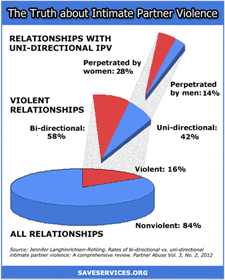Half-Truths and Tall Tales
Effective programs rely on good science and factual information. Unfortunately, many domestic violence groups have spun a web of misleading claims, half-truths, and falsehoods. The biggest myth of all is the claim that men indulge in domestic violence as anexercise in patriarchal privilege. The corollary is the notion that women are incapable of abuse, or at least that female-initiated abuse does not warrant concern.
 Refuting this ideological belief is the CDC National Intimate Partner and Sexual Violence Survey (Tables 4.7 and 4.8), which shows men and women are equally likely to engage in intimate partner violence. This finding is supported by hundreds of other studies, as seen in the graphic to the right.
Refuting this ideological belief is the CDC National Intimate Partner and Sexual Violence Survey (Tables 4.7 and 4.8), which shows men and women are equally likely to engage in intimate partner violence. This finding is supported by hundreds of other studies, as seen in the graphic to the right.
But CEDV’s review of Fact Sheets from leading domestic violence organizations reveals a widespread denial of this and other key facts about intimate partner aggression — see below.
Hiding the truth can have tragic consequences. Each year over 1,000 Americans are killed by an intimate partner (1). Many of these deaths could have been prevented if at-risk persons had been informed about these potentially lethal situations, so they could have taken protective measures:
- Injury is more than twice as likely when the violence was mutual — 28.4% — compared to unidirectional violence — 11.6%, according to a CDC survey (2).
- Female initiation of partner violence is the leading reason for the woman becoming a victim of subsequent injury (3). Dr. Sandra Stith has called it “a dramatically more important factor than anything else” (4).
- Persons who are separated face a risk of partner violence that is 50 times higher the rate of married individuals (5): Married: 0.9/1,000. Separated: 49.0/1,000.
Each of these three risk-factors dramatically increases the chance of a person becoming harmed by his or her intimate partner. But sadly, leading domestic violence organizations are keeping this information under wraps.
Misleading DV information not only does a disservice to victims; it may also promote, in the words of columnist Barbara Kay, a “hatred of men as a group.” See statements HERE.
REPORT CARDS
The Coalition to End Domestic Violence has reviewed the online Fact Sheets of eight DV groups and assigned them a letter grade. All eight Fact Sheets received a failing grade for lack of accuracy and completeness:
- National Network to End Domestic Violence — Grade: F
- Futures Without Violence — Grade: F
- New York State Office for the Prevention of Domestic Violence — Grade: F
- New York City Mayor’s Office to Combat Domestic Violence — Grade: F
- National Coalition Against Domestic Violence — Grade: F
- National Domestic Violence Hotline — Grade: F
- National Council of Juvenile and Family Court Judges — Grade: F
- AVON Foundation for Women — Grade: F
Even when CEDV sent a letter informing these groups about the misleading information and offered to assist in correcting the claims, each group declined to make any changes, without explanation.
FACT SHEET REVIEW
The online Fact Sheets were evaluated using an Assessment Sheet consisting of 10 questions. These questions are based on findings from a variety of studies, including research summarized by the Partner Abuse State of Knowledge (PASK) project.
CEDV staff reviewed the information presented in the Fact Sheet and answered each of the 10 questions ‘Yes’ or ‘No.’ Then we assigned a letter grade based on the number of ‘Yes’ answers:
- A: 9-10
- B: 8
- C: 7
- D: 6
- F: 1-5
References
- FBI: Crime in the United States, 2012. Expanded Homicide Data, Table 10. http://www.fbi.gov/about-us/cjis/ucr/crime-in-the-u.s/2012/crime-in-the-u.s.-2012/offenses-known-to-law-enforcement/expanded-homicide/expanded_homicide_data_table_10_murder_circumstances_by_relationship_2012.xls
- Whitaker DJ et al. Differences in frequency of violence and reported injury between relationships with reciprocal and nonreciprocal intimate partner violence. American Journal of Public Health, Vol. 97, No. 5, 2007.
- Stith S, Smith DB, Penn CE, et al. Intimate partner physical abuse perpetration and victimization risk factors: A meta-analytic review. Aggression and Violent Behavior Vol. 10, 2004. Table 3.
- Press Release. Male College Students Also Victims of Violence at Girlfriends’ Hands. February 12, 2010. http://www.eurekalert.org/pub_releases/2010-02/ksu-mcs021210.php
- Bureau of Justice Statistics: Nonfatal intimate partner violence victimization rate per 1,000 females, by marital status, 1993-2005. http://www.bjs.gov/content/intimate/table/wommar.cfm#
